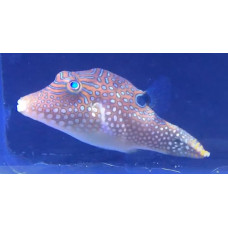Latin name
Canthigaster papua
Other names
False-eye puffer, false-eyed puffer, solander's toby, solandri's sharpnose pufferfish.
Identification
This species can be confused with Canthigaster solandri. It has an elongated body that tapers sharply at the base of the tail feathers.
Features of fish fins
Dorsal soft rays: 8-10; anal soft rays: 8-10.
Fish colouring
Brownish fish with numerous small bluish-green spots, bluish-green lines with black edges diverging from the eyes, two (rarely three) longitudinal blue lines on the underside of the head, orange chin (in adults), longitudinal light blue lines between the eye and the beginning of the dorsal fin, and a black spot with a blue edge at the base of the dorsal fin.
Distribution
Widespread in the tropical waters of the Indian Ocean and western Pacific.
Habitat
It is a bottom dwelling marine fish. It lives on coral reefs with clear water in lagoons and even on the outer slopes with a height difference of 6 to 50 metres.
Size
A small fish that grows to 10 cm.
Behavior
The species is diurnal. Adults are often found in pairs along deep cliffs, while juveniles can be found in shallow estuaries.
Food and feeding habits
An omnivorous fish.
Reproduction
Oviparous fish.
Fishing
No commercial value.
Relationship with a person
Occasionally finds its way into the aquarium trade. Poisonous.
| Classification | |
| Phylum | Chordata |
| Class | Actinopterygii |
| Squad | Tetraodontiformes |
| Family | Tetraodontidae |
| Genus | Canthigaster |
| Species | C. papua |
| Features | |
| Conservation status | Least Concern |
| Habitat | Bottom |
| Life span, years | No information |
| Maximum body weight, kg | No information |
| Maximum length, cm | 10 |
| Sailing speed, m/s | No information |
| Threat to people | Not edible |
| Way of eating | Planktonophage |
Papuan toby
Tags: papuan toby



